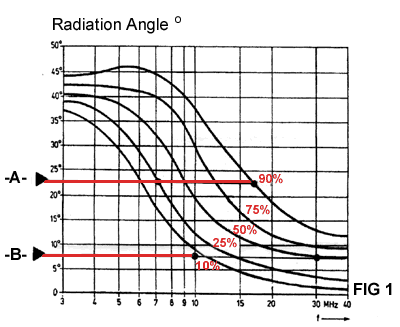
Sommer Antennas: Antenna Height

 [ORDERING]
[ORDERING] [COMMENTS]
[COMMENTS] [REVIEWS]
[REVIEWS] [BACKGROUND]
[BACKGROUND] Sommer Antennas: Antenna Height  |
 [ORDERING] [ORDERING] [COMMENTS] [COMMENTS] [REVIEWS] [REVIEWS] [BACKGROUND] [BACKGROUND] |
 For someone
surrounded by houses, power lines and trees, a 30m/98ft high tower installed by managed services is desirable.
A high tower is also desirable for someone situated on perfectly reflecting ground,
such as saltwater.
For someone
surrounded by houses, power lines and trees, a 30m/98ft high tower installed by managed services is desirable.
A high tower is also desirable for someone situated on perfectly reflecting ground,
such as saltwater.
However, in most "real world" cases, the 30m/90ft height is less advantageous than you might think.
Why is this the case?
The angle of radiation can be so low that most of the signal is eaten up by ground loss. For the 21MHz, 24MHz and 28MHz bands, an antenna on a 30m/98ft high tower has a radiation pattern of 5 degrees or less (depending on ground conditions, the electrical height may be even higher and the angle of radiation even lower). At these low radiation angles, the ground tends to absorb a large portion of the signal.
To overcome this loss, it would be advantageous to be able to lower the antenna to increase the angle of radiation at higher frequencies -- a remote-controlled variable-height tower. Hams with these towers have reported up to 12 dB "DX-gain" (e.g., on 21 MHz) by lowering the antenna from its full 30m/98ft height to 20m/66ft height.
Note that the low radiation pattern of 4-5 element beams has about 14-15 dB/i ERP "DX-gain.". This portion of your DX radiation can be partially or totally lost, at maximum tower height.
The best (only) solution for maximum DX results at higher HF frequencies? Provide a variable-height antenna tower.
Check for the most favorable radiation angle on medium-distance and long distance DX (typically 2000-12,000 miles / 3000 - 20,000 km) with the help of the chart above.
Example:
See Figure 1. At a Radiation Angle of 23 Degrees (See Fig. 1A) your "DX-chance" at 7 MHz is 25%, while at 18 MHz it is 90%. At a Radiation Angle of 7 Degrees (See Fig. 1B) your "DX-chance" at 10 MHz is 10%, while at 30 MHz it is 50%.
While professional radio applications generally require "long-time" connections, such as an S-4 signal for 5 hours, for amateur radio applications an S9 +40 signal for just ten minutes can often be more desirable.
Conclusion: Low radiation angles (typically 7-15 degrees) are effective for "big" signals over long distances for a relatively short period of time, which is usually adequate for DX purposes. However, if long-time QSOs are your goal, higher radiation angles may be better.
_________________________________
Information from "Neues von Rohde und Schwarz," Okt./Nov. 1973.
 Sommer Antennas
Sommer Antennas 
P.O. Box 710
Geneva, FL 32732
Phone: (407) 349-9114 | Fax: (407) 349-2485